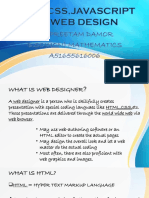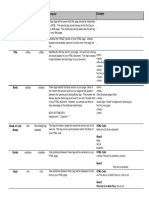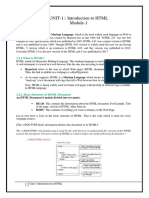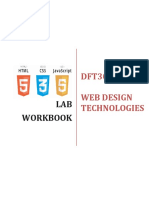0 ratings0% found this document useful (0 votes)
19 viewsLesson 3 HTML Introduction
This document is an introduction to HTML that covers basic syntax and text formatting, images, links, lists, and tables. It defines HTML as a markup language used to describe web pages and notes that HTML documents contain tags and plain text. The document explains HTML page structure using common tags like <html>, <body>, and <h1>. It also covers how browsers display HTML, common HTML tags, and tools for editing HTML. The document provides details on how to add images, links, lists, and tables to HTML pages.
Uploaded by
David KimathiCopyright
© © All Rights Reserved
Available Formats
Download as PDF, TXT or read online on Scribd
0 ratings0% found this document useful (0 votes)
19 viewsLesson 3 HTML Introduction
This document is an introduction to HTML that covers basic syntax and text formatting, images, links, lists, and tables. It defines HTML as a markup language used to describe web pages and notes that HTML documents contain tags and plain text. The document explains HTML page structure using common tags like <html>, <body>, and <h1>. It also covers how browsers display HTML, common HTML tags, and tools for editing HTML. The document provides details on how to add images, links, lists, and tables to HTML pages.
Uploaded by
David KimathiCopyright
© © All Rights Reserved
Available Formats
Download as PDF, TXT or read online on Scribd
You are on page 1/ 7
Web Design and Development Lesson 3
Lesson 3: HTML Introduction
Lesson 3: HTML Introduction ....................................................................................................................... 1
3.1 Definition and Brief Introduction ................................................................................................ 2
3.2 Basic Syntax and Text Formatting................................................................................................ 2
3.2.1 HTML Example ...................................................................................................................... 2
3.2.2 HTML Page structure............................................................................................................. 2
3.2.3 Web Browser......................................................................................................................... 3
3.2.4 HTML Tags ............................................................................................................................. 3
3.2.5 HTML Editor .......................................................................................................................... 3
3.2.6 HTML Formatting .................................................................................................................. 4
3.3 HTML Images ................................................................................................................................ 4
3.4 HTML Links.................................................................................................................................... 5
3.5 HTML Lists ..................................................................................................................................... 5
3.6 HTML Tables ................................................................................................................................. 6
Lesson 3 Discussion Session ..................................................................................................................... 7
Compiled by: Karari E.K email: cats.mwalimu@gmail.com 1
Web Design and Development Lesson 3
3.1 Definition and Brief Introduction
• HTML is a language for describing web pages. It stands for Hyper Text Markup Language
• HTML is a markup language with a set of markup tags that describe document content.
• HTML documents contain HTML tags and plain text. HTML documents are also called web
pages.
Originally, HTML was developed with the intent of defining the structure of documents like
headings, paragraphs, lists, and so forth to facilitate the sharing of scientific information
between researchers. All you need to do to use HTML is to learn what type of markup to use to
get the results you want.
3.2 Basic Syntax and Text Formatting
HTML tags are keywords (tag names) surrounded by angle brackets like <html>.
HTML tags normally come in pairs like <b> and </b> ; the first tag in a pair is the start tag, and
the second tag is the end tag.
The end tag is written like the start tag, with a forward slash before the tag name.
Start and end tags are also called opening tags and closing tags.
3.2.1 HTML Example
• The DOCTYPE declaration defines the
document type.
• The text between <html> and </html>
describes the web page.
• The text between <body> and </body> is
the visible page content.
• The text between <h1> and </h1> is
displayed as a heading.
• The text between <p> and</p> is displayed
as a paragraph.
3.2.2 HTML Page structure
Compiled by: Karari E.K email: cats.mwalimu@gmail.com 2
Web Design and Development Lesson 3
3.2.3 Web Browser
The purpose of a web browser (Chrome, Edge, Firefox, Safari) is to read HTML documents and
display them correctly. A browser does not display the HTML tags, but uses them to determine
how to display the document.
3.2.4 HTML Tags
For more HTML tags: https://www.w3schools.com/tags/default.asp
3.2.5 HTML Editor
HTML can be edited by using a professional HTML editor like:
Sublime Text
Adobe Dreamweaver
Microsoft Expression Web
CoffeeCup HTML Editor
However, for learning HTML I can recommend a text editor like: Notepad++
Compiled by: Karari E.K email: cats.mwalimu@gmail.com 3
Web Design and Development Lesson 3
3.2.6 HTML Formatting
HTML Formatting is a process of formatting text for better look and feel. There are many
formatting tags in HTML. These tags are used to make text bold, italicized, or underlined. There
are almost 14 options available that how text appears in HTML and XHTML.
In HTML the formatting tags are divided into two categories:
Physical tag: These tags are used to provide the visual appearance to the text.
Logical tag: These tags are used to add some logical or semantic value to the text.
3.3 HTML Images
Images enhance visual appearance of the web pages by making them more interesting and
colorful.
The <img> tag is used to insert images in the HTML documents. It is an empty element and
contains attributes only. The syntax of the <img> tag can be given with:
<img src="url" alt="some_text">. The src attribute specifies the path to the image to bed
displayed. The alt attribute defines an alternate text for the image, if it can't be displayed.
Compiled by: Karari E.K email: cats.mwalimu@gmail.com 4
Web Design and Development Lesson 3
3.4 HTML Links
In HTML, links are defined with the <a> tag:
The HTML anchor tag <a> defines a hyperlink that links one page to another page. It can create
hyperlink to other web page as well as files, location, or any URL. Href (pronounced "h" — like
the letter — "ref) is short for Hypertext Reference. This is a goofy name that really only means a
URL (otherwise known as a web site address).<a href="url">link text</a> Eg:
<a href="https://www.w3schools.com">Visit W3Schools</a>
3.5 HTML Lists
HTML offers web authors three ways for specifying lists of information. All lists must contain
one or more list elements. Lists may contain -
<ul> - An unordered list. This will list items using plain bullets- disc, circle, or square.
<ol> - An ordered list. This will use different schemes of numbers to list your items- 1, ‘A’, ‘a’,
‘I’, or ‘i’.
<dl> - A definition list. This arranges your items in the same way as they are arranged in a
dictionary. The <dl> tag defines the description list, the <dt> tag defines the term (name), and
the <dd> tag describes each term.
Compiled by: Karari E.K email: cats.mwalimu@gmail.com 5
Web Design and Development Lesson 3
3.6 HTML Tables
A table is a grid of rows and columns, the intersections of which form cells. Each cell is a distinct
area, into which you can place text, graphics, or even other tables.
Tables are defined with the <table> tag.
Tables are divided into table rows with the <tr> tag.
Table rows are divided into table data with the <td> tag.
A table row can also be divided into table headings with the <th> tag.
The colspan attribute can be used on a <th> or <td> element and indicates how many columns
that cell should run across.
The rowspan attribute can be used on a <td> or <td> element to indicate how many rows a cell
should span down the table.
By default, a table has no border. To add a one-pixel border around both the table as
a whole and around each individual cell, you can add this attribute to the <table> tag
<table border =”1”>.
Example:
<table border= 1>
<tr>
<td colspan="3" align="center"> Student Attendance Record </td>
</tr>
<tr>
<td>CAMPUS</td>
<td>MAIN</td>
<td>CITY</td>
</tr>
<tr>
<td>Less than 1,000 Students</td>
<td rowspan="2">14<sup>th</sup> Feb 2022</td>
<td>14<sup>th</sup> Feb 2022</td>
</tr>
<tr>
<td>1,000 and Over</td>
<td>14<sup>th</sup> Feb 2022</td>
</tr>
</table>
Compiled by: Karari E.K email: cats.mwalimu@gmail.com 6
Web Design and Development Lesson 3
Lesson 3 Discussion Session
1. Differentiate between absolute and relative URLs.
2. Discuss img formatting in HTML
3. Explain HTML blocks and inline element using <frame> and <div> tags.
Compiled by: Karari E.K email: cats.mwalimu@gmail.com 7
You might also like
- Section 1 HTML (Hypertext Markup Language)No ratings yetSection 1 HTML (Hypertext Markup Language)24 pages
- Web Design & Development: Week 02 by Shakeel AhmadNo ratings yetWeb Design & Development: Week 02 by Shakeel Ahmad94 pages
- Prof. Varsha Tank (IT/ICT Dept. - Ljiet) : Presented by100% (1)Prof. Varsha Tank (IT/ICT Dept. - Ljiet) : Presented by12 pages
- HTML Introduction: Structure and Formatting Tags100% (1)HTML Introduction: Structure and Formatting Tags17 pages
- HTML Tutorials - I-Tech Software Education100% (1)HTML Tutorials - I-Tech Software Education50 pages
- M6 T1 Netiquette Materials For Parents TeachersNo ratings yetM6 T1 Netiquette Materials For Parents Teachers27 pages
- Module 8: Using Internal CSS Module 8: Using Internal CSSNo ratings yetModule 8: Using Internal CSS Module 8: Using Internal CSS23 pages
- Online Platform Tools For ICT Content DevelopmentNo ratings yetOnline Platform Tools For ICT Content Development19 pages
- Lab WorkBook and Activity HTML CSS JavaS PDFNo ratings yetLab WorkBook and Activity HTML CSS JavaS PDF64 pages
- HTML Tags Chart: Tag Name Code Example Browser View100% (12)HTML Tags Chart: Tag Name Code Example Browser View9 pages
- Computer Science Lesson Plan Week 1-PracticalNo ratings yetComputer Science Lesson Plan Week 1-Practical2 pages
- Full Download Sams Teach Yourself HTML and XHTML in 24 Hours 6th Edition Dick Oliver PDF100% (8)Full Download Sams Teach Yourself HTML and XHTML in 24 Hours 6th Edition Dick Oliver PDF84 pages
- Day Wise Topic of Web Designing: SR. NO Day Content Date Remarks SignNo ratings yetDay Wise Topic of Web Designing: SR. NO Day Content Date Remarks Sign6 pages
- Using The BIRT Report Viewer-AJAX Based J2EE Application100% (7)Using The BIRT Report Viewer-AJAX Based J2EE Application13 pages
- Chatter Administrator's Workbook: Version 2: Spring '13No ratings yetChatter Administrator's Workbook: Version 2: Spring '1330 pages
- Syllabus Computer Science Admitted Batch 2008 - 2009 (UG Courses)No ratings yetSyllabus Computer Science Admitted Batch 2008 - 2009 (UG Courses)44 pages
- Javascript - Step by Step Notes On Building JScriptNo ratings yetJavascript - Step by Step Notes On Building JScript28 pages
- Fullstack Development Blockchain DiplomaNo ratings yetFullstack Development Blockchain Diploma16 pages
- 1000 HTML MCQ (Multiple Choice Questions) - SanfoundryNo ratings yet1000 HTML MCQ (Multiple Choice Questions) - Sanfoundry16 pages
- Text Mining Digital Humanities Projects Assessing Content Analysis Capabilities of Voyant ToolsNo ratings yetText Mining Digital Humanities Projects Assessing Content Analysis Capabilities of Voyant Tools30 pages
- Fundamentals of Web Development 3rd Edition Randy ConnollyNo ratings yetFundamentals of Web Development 3rd Edition Randy Connolly49 pages
- Web Design & Development: Week 02 by Shakeel AhmadWeb Design & Development: Week 02 by Shakeel Ahmad
- Prof. Varsha Tank (IT/ICT Dept. - Ljiet) : Presented byProf. Varsha Tank (IT/ICT Dept. - Ljiet) : Presented by
- Module 8: Using Internal CSS Module 8: Using Internal CSSModule 8: Using Internal CSS Module 8: Using Internal CSS
- HTML Tags Chart: Tag Name Code Example Browser ViewHTML Tags Chart: Tag Name Code Example Browser View
- Full Download Sams Teach Yourself HTML and XHTML in 24 Hours 6th Edition Dick Oliver PDFFull Download Sams Teach Yourself HTML and XHTML in 24 Hours 6th Edition Dick Oliver PDF
- Day Wise Topic of Web Designing: SR. NO Day Content Date Remarks SignDay Wise Topic of Web Designing: SR. NO Day Content Date Remarks Sign
- Using The BIRT Report Viewer-AJAX Based J2EE ApplicationUsing The BIRT Report Viewer-AJAX Based J2EE Application
- Chatter Administrator's Workbook: Version 2: Spring '13Chatter Administrator's Workbook: Version 2: Spring '13
- Syllabus Computer Science Admitted Batch 2008 - 2009 (UG Courses)Syllabus Computer Science Admitted Batch 2008 - 2009 (UG Courses)
- Javascript - Step by Step Notes On Building JScriptJavascript - Step by Step Notes On Building JScript
- 1000 HTML MCQ (Multiple Choice Questions) - Sanfoundry1000 HTML MCQ (Multiple Choice Questions) - Sanfoundry
- Text Mining Digital Humanities Projects Assessing Content Analysis Capabilities of Voyant ToolsText Mining Digital Humanities Projects Assessing Content Analysis Capabilities of Voyant Tools
- Fundamentals of Web Development 3rd Edition Randy ConnollyFundamentals of Web Development 3rd Edition Randy Connolly

























































































